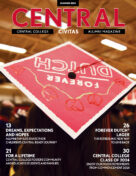 Nyla Rozeboom Heerema ’63, spends every day staring at something she finds absolutely beautiful—the human chromosome. It may not be the Mona Lisa, but for a cytogeneticist, nothing could be more compelling.
Nyla Rozeboom Heerema ’63, spends every day staring at something she finds absolutely beautiful—the human chromosome. It may not be the Mona Lisa, but for a cytogeneticist, nothing could be more compelling.
“It’s like a puzzle every time we find an abnormality, which is several a day,” says Heerema.
Cytogenetics is the study of human chromosomes in health and disease. Chromosomes are thread-like structures inside the nucleus of a cell that contain DNA. As a professor of pathology and director of cytogenetics at Ohio State University, Heerema spends about half her time on research and half her time on clinical work—analyzing the chromosomes of patients awaiting treatment. Her main focus is cancer, particularly leukemia.
 After graduating from Central in 1963, Heerema went on to earn a Ph.D. in genetics from the University of Iowa—a program that was designed specifically for her, since genetics was such a new field. Later, Heerema did a postdoctoral fellowship in human genetics at Indiana University, where she stayed as a faculty member for nearly two decades. Before moving to Ohio, she did research at the Hughes Medical Institute in Minnesota, a large privately funded organization for medical research.
After graduating from Central in 1963, Heerema went on to earn a Ph.D. in genetics from the University of Iowa—a program that was designed specifically for her, since genetics was such a new field. Later, Heerema did a postdoctoral fellowship in human genetics at Indiana University, where she stayed as a faculty member for nearly two decades. Before moving to Ohio, she did research at the Hughes Medical Institute in Minnesota, a large privately funded organization for medical research.
Cancer is an extremely complicated disease, and the best way to understand a patient’s situation is to dive into the chromosomes. Two different patients with the same disease and the same symptoms may have completely different cytogenetics, meaning their chromosomes have different abnormalities. And those abnormalities influence prognosis and treatment.
“I interact with people who are working on the development of drugs,” says Heerema. “Some of the abnormalities I find respond differently to different treatments. One patient with a specific abnormality may respond to a drug, and another with a different abnormality might not.”
Heerema specializes in pediatric acute lymphoblastic leukemia, which is the most common form of childhood leukemia. She analyzes patients’ chromosomes and then defines their level of risk—from “lower than standard risk” to “very high risk.” These definitions are constantly changing, and her research refines them by discovering abnormalities that affect a patient’s risk level.
Her other specialty is adult chronic lymphocytic leukemia, the most common form in adults. Patients can live up to 20 years without problems, but some may die within a few months. Heerema’s job is to figure out which patients are which. A diagnosis of either “aggressive” or “indolent” leads to different treatment options.
Heerema doesn’t think a cure for cancer is right around the corner, like some people believe. There are just too many diseases that fall under the catch-all of “cancer.” Even though no universal cure is in sight, Heerema sees reasons for hope. “We’re learning so much more about the biology of different cancer cells,” she says. “Once we understand what’s wrong in the cancer cell, we have a much better chance of getting rid of it.”
And so Heerema keeps quietly plugging away—gazing at chromosomes that will hopefully lead to new ways of defining, diagnosing and treating, as they have in the past. Even though she works in a lab, she is helping patients every day. Just by looking at the squiggly lines inside a cell.












To encourage serious, intellectual discourse on Civitas, please include your first and last name when commenting. Anonymous comments will be removed.
Comments are closed.